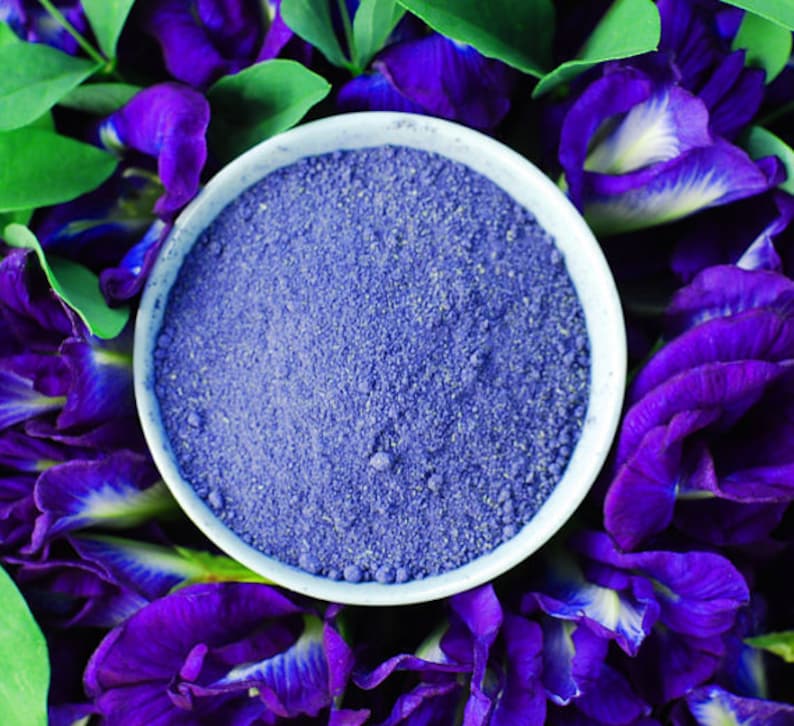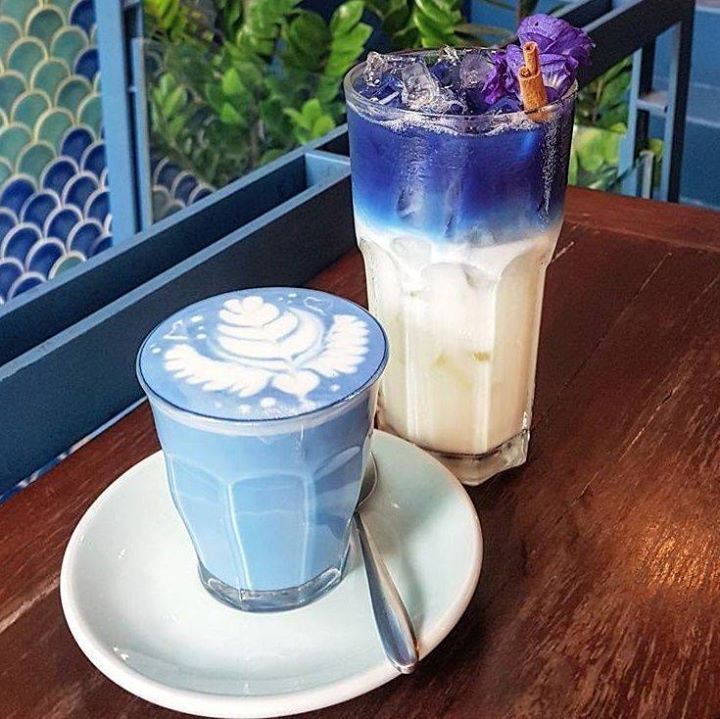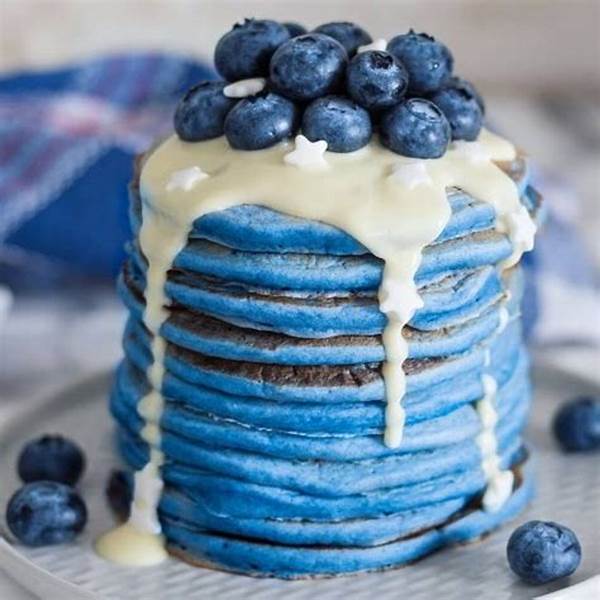Do you know the latest foodie trend that has taken netizens by storm? Yes, I am talking about the Blue Matcha which has racked up millions of views on TikTok and other social media platforms.
If you have come across any video of this “Blue mermaid drink”. Then you might be wondering, What does Blue Matcha taste like?
Continue reading this article to know more about this trendy alternative to green matcha.

What Is Blue Matcha?
Blue matcha is a vibrantly colored, trendy alternative to traditional green matcha that has been gaining popularity in recent years. Blue matcha is derived from the butterfly pea flower, has a unique flavor, and is used as a natural food coloring agent.
History of Blue Matcha
In order to understand what does blue matcha taste like, you have to know its history. While green matcha has been a popular beverage for centuries, blue matcha has a more recent history.
In Southeast Asia, where the butterfly pea flower is native, the flower has been used for traditional medicinal purposes, as well as for cooking and coloring food.
In recent years, the trend of using butterfly pea flower powder has gained traction in wellness and health communities. Now it has even gained importance in cafes and restaurants around the world.
What Does Blue Matcha Taste Like?
Blue matcha has a milder, smoother flavor than regular matcha. Its taste profile is often described as vegetal and earthy, with subtle notes of floral sweetness.
The flavor is gentle and not overpowering, making it an excellent choice for those who are new to matcha. Here are some of the specific flavor notes that you can expect:
Blue Matcha Visual Appeal
Butterfly pea flower is the ingredient that gives blue matcha its unique color. The flower is dried and then ground into a fine powder before being used in a variety of culinary applications.
Whether you’re sipping on a refreshing blue matcha latte or creating a culinary masterpiece on how to know what does blue matcha taste like, blue matcha is sure to elevate your taste buds and your Instagram feed.

Primary Flavor Notes
Below are the primary flavor notes and characteristics of blue matcha:
Subtle Earthiness:
If you’re familiar with traditional green matcha, you likely noticed its distinct, grassy flavor. Blue matcha shares some of that but with an earthy undertone.
The earthy notes come from the blend of green tea and blue butterfly pea flower, which provides a rich and complex flavor. Blue matcha’s flavor is not as grassy as traditional green tea, but it still has a fresh, vegetal quality.
Floral Notes:
The floral notes in blue matcha are subtle and add a depth of flavor to the tea. These notes are a result of the butterfly pea flower used to make blue matcha, which contributes to its unique flavor profile.
Sweetness and Refreshing Qualities
It is as overpowering as sugar but enough to counterbalance its natural bitterness.
The sweetness is not an added flavor like sugar, but rather it comes from amino acids like L-Theanine which enhances the natural sweetness and mellowness.
This specialized flavor makes it an excellent option for an accompaniment to any dessert, whether it’s sweet or not.
Does Blue Matcha Have Caffeine
Blue matcha typically doesn’t contain caffeine. It’s made from the flowers of the Clitoria ternatea plant and is caffeine-free.
If the blue matcha is blended with other tea leaves or ingredients that contain caffeine, then it could potentially have some caffeine content.
If you’re looking for a caffeine-free option, pure blue matcha should be a good choice.
Benefits Of Blue Matcha
Aside from its flavor, this vibrant blue beverage has numerous health and wellness benefits, making it a popular choice among those looking to improve their overall well-being.
Here are some of the benefits that blue matcha can offer:
Physical Benefits
- Skin health:
The antioxidants present in blue matcha can help fight against free radicals, which can damage the skin and cause premature aging.
- Weight management:
Blue matcha is low in calories and can help boost metabolism, making it a great addition to weight management diets.
- Healthy digestion:
Blue matcha can help to improve digestion by reducing inflammation in the gut and promoting the growth of healthy gut bacteria.
Mental Benefits
In addition to its physical benefits, blue matcha can also have a positive impact on mental health and well-being.
- Increased focus:
The caffeine and antioxidants in blue matcha can help to improve focus and concentration, making it a great alternative to coffee or other caffeinated beverages.
- Relaxation:
Blue matcha contains an amino acid called L-theanine, which can help to promote relaxation and reduce stress and anxiety.
Skin Benefits
Besides knowing what does blue matcha taste like, you must know that it also share numerous skin benefits. One of the most well-known benefits of blue matcha is its potential for improving skin health.
- Antioxidant-rich:
Blue matcha is rich in antioxidants, which can help to protect the skin from damage caused by free radicals and environmental stressors.
- Anti-inflammatory:
The anti-inflammatory properties of blue matcha can help to reduce inflammation and redness in the skin.
- Reduces under-eye puffiness and dark circles:
The natural cooling effect of blue matcha can help to reduce under-eye puffiness and dark circles.
- Hydrating:
Blue matcha can help to hydrate the skin and improve its overall appearance and texture.
Overall, blue matcha is a refreshing and delicious beverage that offers a wide range of health and wellness benefits. Whether you’re looking to improve your skin health or boost your mental focus, blue matcha is definitely worth incorporating into your daily routine.
Blue Matcha vs. Green Matcha
Blue matcha and green matcha are both unique types of teas, but they have some distinct differences:
- Color and Source:
- Blue Matcha: Blue matcha is made from butterfly pea flower petals, giving it a vibrant blue color. It’s often used as a natural food coloring and is known for its striking appearance.
- Green Matcha: Green matcha is made from shade-grown tea leaves, specifically Camellia sinensis plants. The leaves are ground into a fine powder, that results in a bright green color.
- Flavor:
- Blue Matcha: Butterfly pea flower tea (blue matcha) has a mild, earthy, and slightly floral flavor. It’s often enjoyed for its visual appeal rather than its flavor.
- Green Matcha: Green matcha has a distinct and robust flavor that can range from grassy and vegetal to slightly sweet and umami. It’s known for its rich taste and is used in traditional Japanese tea ceremonies.
- Caffeine Content:
- Blue Matcha: Blue matcha is generally caffeine-free since it’s made from butterfly pea flowers, which do not contain caffeine.
- Green Matcha: Green matcha does contain caffeine due to its origin from tea leaves. However, the caffeine content is generally lower than that of other types of tea due to the shading process the tea plants undergo before harvest.
- Health Benefits:
- Blue Matcha: Butterfly pea flower tea is often celebrated for its antioxidants and potential health benefits, including its reported ability to support cognitive function and promote healthy hair and skin.
- Green Matcha: Green matcha is well-known for its high concentration of antioxidants, particularly catechins like EGCG. It’s associated with a range of potential health benefits, including improved metabolism, energy, and mental focus.
- Usage:
- Blue Matcha: Blue matcha is commonly used as a natural dye in beverages, cocktails, and foods. It’s also sometimes mixed with other ingredients to create colorful and visually appealing dishes.
- Green Matcha: Green matcha is traditionally prepared by whisking powdered tea with hot water to create a frothy and invigorating beverage. It’s also used in baking, cooking, and various culinary creations.
In summary, Blue matcha is more about its striking color and potential health benefits, while green matcha is famous for its distinct flavor profile and well-documented health advantages.
4 Fun Ways To Use Blue Matcha
1. Blue Matcha Smoothie Bowl
Try out this amazing smoothie to know what does blue matcha taste like. Blue matcha pairs well with fruits such as bananas, berries, and mangoes used in smoothies, giving them a vibrant blue hue.
You can try this mouthwatering smoothie bowl to make your mornings colorful.
Ingredients:
- 1 frozen banana
- 1 cup frozen blueberries
- 1/2 cup Greek yogurt
- 1 teaspoon blue matcha powder
- 1/2 cup almond milk (or any preferred milk)
- Toppings: sliced strawberries, granola, chia seeds, coconut flakes
Instructions:
- In a blender, combine the frozen banana, frozen blueberries, Greek yogurt, blue matcha powder, and almond milk.
- Blend until smooth and creamy, adjusting the consistency with more almond milk if needed.
- Pour the smoothie mixture into a bowl.
- Decorate the top with sliced strawberries, granola, chia seeds, and coconut flakes.
- Dive in with a spoon and enjoy the refreshing and colorful blue matcha smoothie bowl!

2. Blue Matcha Iced Latte
One of the most popular ways to enjoy blue matcha is by making a latte. To bring an end to your curiosity on what does blue matcha taste like, try out this latte! A blue matcha latte is a great way to experience the unique taste profile of blue matcha.
With this latte recipe, you can create a delicious and refreshing drink with just a few simple ingredients!
Ingredients:
- 1 teaspoon blue matcha powder
- 1 tablespoon hot water
- 1 cup cold milk (dairy or plant-based)
- Sweetener of choice (e.g., honey, maple syrup)
- Ice cubes
Instructions:
- In a glass, whisk the blue matcha powder and hot water until well combined.
- Add the cold milk to the glass and stir until fully mixed.
- Sweeten the latte with your preferred sweetener, adjusting the amount to taste.
- Drop in a handful of ice cubes and stir gently.
- Sip and savor the cool and creamy blue matcha latte, reveling in its unique flavor and stunning blue hue.

3. Blue Matcha Energy Balls
Whip up a batch of these irresistible Blue Matcha Energy Balls for a nutritious and vibrant snack on the go! So next time, any friend of yours asks what does blue matcha taste like, give them these energy balls!
Combining the natural sweetness of dates, the crunch of raw almonds, and the subtle earthy notes of blue matcha powder, these energy balls are a delightful burst of flavor and color.
Ingredients:
- 1 cup pitted dates
- 1 cup raw almonds
- 2 tablespoons almond butter
- 1 tablespoon blue matcha powder
- 1/4 cup shredded coconut (plus extra for rolling)
- 1/2 teaspoon vanilla extract
- Pinch of salt
Instructions:
- In a food processor, combine the dates, almonds, almond butter, blue matcha powder, shredded coconut, vanilla extract, and salt.
- Process until the mixture becomes sticky and holds together when pressed between your fingers.
- Take small portions of the mixture and roll them into bite-sized balls.
- Roll the energy balls in shredded coconut to coat the exterior.
- Place the balls in an airtight container and refrigerate for at least 30 minutes to firm up.
- Enjoy these vibrant and nutritious blue matcha energy balls as a quick and satisfying snack.

4. Blue Matcha Pancakes
What does blue matcha taste like? Indulge in a stack of fluffy Blue Matcha Pancakes that are as visually stunning as they are delicious.
These pancakes combine the light and airy texture of traditional pancakes with a vibrant twist of blue matcha powder. This answers what does blue matcha taste like.
Ingredients:
- 1 cup all-purpose flour
- 1 tablespoon blue matcha powder
- 2 tablespoons sugar
- 1 teaspoon baking powder
- 1/2 teaspoon baking soda
- 1 cup buttermilk
- 1 large egg
- 1 tablespoon melted butter
- Cooking spray or additional butter for greasing the pan
Instructions:
- In a mixing bowl, whisk together the flour, blue matcha powder, sugar, baking powder, and baking soda.
- In a separate bowl, whisk together the buttermilk, egg, and melted butter.
- Pour the wet ingredients into the dry ingredients and stir until just combined. It’s okay if there are a few lumps.
- Heat a non-stick pan or griddle over medium heat and lightly coat with cooking spray or butter.
- Pour 1/4 cup of the pancake batter onto the pan for each pancake.
- Cook until bubbles form on the surface, then flip and cook for another minute or until golden brown.
- Repeat with the remaining batter.
- Serve the blue matcha pancakes stacked high, drizzled with maple syrup or honey, and topped with fresh berries for a delightful and visually stunning breakfast treat.

Final Thoughts:
Now you must know What does Blue Matcha Taste Like?
Throughout this article, we’ve explored the unique and vibrant world of blue matcha. From its origins and ingredients to its flavor profile and benefits, we’ve delved deep into this fascinating and trendsetting beverage.
If even now, you don’t know what does blue matcha taste like . Consider your next culinary adventure, by giving blue matcha a try. Whether you’re a matcha enthusiast or simply looking to try something new, blue matcha has something unique and appealing to offer.
FAQs
Can you make a latte with blue matcha?
Yes, you can make a delicious blue matcha latte with blue matcha powder and milk or non-dairy milk. Simply mix the powder with hot water, add steamed milk, and enjoy a refreshing and flavorful latte with a vibrant blue color.
What are the benefits of blue matcha?
Blue matcha has several potential health benefits, including antioxidant and anti-inflammatory properties that can improve skin health, aid in weight loss, and improve digestion. It also contains a moderate amount of caffeine, which can provide energy and improve mental focus.
